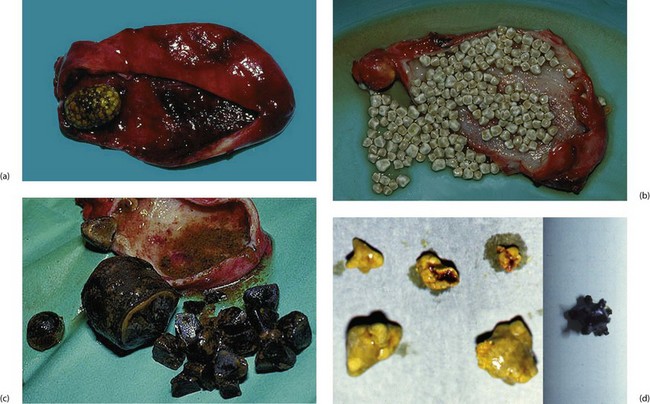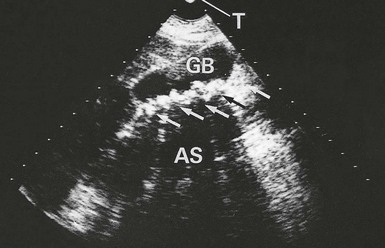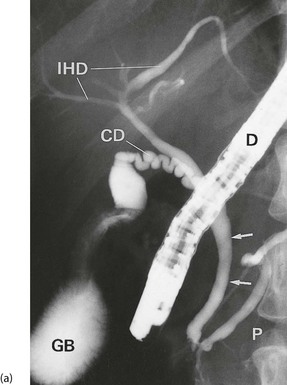Gallstone diseases and related disorders
Structure and function of the biliary system
Bile collects in canaliculi between hepatocytes and drains via collecting ducts within the portal triads into a system of ducts within the liver. These progressively increase in diameter until they become the right and left hepatic ducts which fuse to form the common hepatic duct. This is joined further distally by the cystic duct to become the common bile duct (Fig. 20.1). The common bile duct is 4–5 cm long and passes down behind the duodenum then through the head of the pancreas to drain via the ampulla of Vater into the medial wall of the second part of the duodenum. In most cases, the main pancreatic duct joins the common bile duct at the ampulla although it may enter the duodenum independently. The sphincter of Oddi within the ampulla prevents reflux of duodenal contents into the common bile duct and pancreatic duct.

Fig. 20.1 Surgical anatomy of the gall bladder, biliary tract and pancreas
The coeliac trunk (the foregut artery) arises from the aorta and divides into the hepatic, splenic and left gastric arteries. The hepatic artery divides into right and left branches, mirrored by the extrahepatic right and left hepatic ducts. These join caudally to form the common hepatic duct; this in turn is joined by the cystic duct to form the common bile duct (CBD). The porta hepatis consists of the hepatic arteries, the extrahepatic bile ducts and the portal vein
Pathophysiology of the biliary system
Gallstone composition
In developed countries, most gallstones are of mixed composition and contain a predominance of cholesterol; this is mixed with some bile pigment (calcium bilirubinate) and other calcium salts. A small proportion is virtually ‘pure’ cholesterol stones (‘cholesterol solitaire’). In Asia, most gallstones are composed of bile pigment alone. The composition and pathogenesis of the various types of gallstone are summarised in Table 20.1 (and see Fig. 20.2), and some examples are illustrated in Figure 20.3.

Fig. 20.2 X-ray of radiopaque gallstone
Plain abdominal X-ray showing large radiopaque gallstone in the right upper quadrant. Note that the stone is obviously laminated, having built up in layers over many years. Note also that only 10% of mixed stones are radiopaque

Fig. 20.3 Types of gallstone
(a) Thick-walled chronically inflamed gall bladder found to be obstructed at its neck by a single stone. Note the stone is an aggregate of many smaller stones
(b) Multiple small gallstones in the gall bladder, all of much the same ‘generation’.
(c) Gall bladder containing one huge stone and multiple smaller stones. These stones all fitted together with adjoining facets.
(d) Different types of gallstones—pale irregular stones of different ages on the left and a pigment ‘jack’ stone on the right
Investigation of gall bladder pathology
When gallstone disease is suspected, investigation has the following objectives:
• Exclude haematological and liver abnormalities and other metabolic disorders
• Establish if gallstones are present in the gall bladder and/or common duct and whether the gall bladder wall is thickened
• Assess the integrity and patency of the bile duct system and the pancreatic duct (if there is any suggestion of obstruction)
Blood tests for haematological and liver abnormalities: Haemolytic disorders such as hereditary spherocytosis, thalassaemia and sickle-cell trait should be considered as they may predispose to pigment stones. Liver function tests (LFTs) are indicated to look for indications of common duct stone obstruction if there is any suggestion of jaundice and to exclude other liver abnormalities.
Imaging in investigating gall bladder pathology: Ultrasonography (see Fig. 20.4) can reliably identify stones in the gall bladder and any increase in thickness of the wall (caused by inflammation or fibrosis). Ultrasound also provides a simple and accurate means of demonstrating dilatation of the common duct system, often indicating distal duct obstruction. Unfortunately, it is unreliable for directly identifying bile duct stones, particularly at the lower end, because the image tends to be obscured by overlying duodenal gas. Ultrasound has the great advantage of being suitable for use in the seriously ill or jaundiced patient as it is non-invasive and can be performed at the bedside.

Fig. 20.4 Biliary ultrasound scans
Longitudinal scan of gall bladder in a 46-year-old woman who complained of intermittent attacks of right upper quadrant pain. The scan shows the outline of the gall bladder GB and a layer of gallstones (arrowed) along its posterior wall. The stones each cast a clear acoustic shadow AS beyond them. Note that these shadows can be projected back to the transducer T
Investigating the biliary duct system: See Figure 20.5.


Fig. 20.5 Investigation of the biliary duct system
(a) Normal ERCP showing duodenoscope D in the second part of the duodenum. Contrast has been injected first into the pancreatic duct P and then into the common bile duct (arrowed). Note also the cystic duct CD, gall bladder GB and intrahepatic bile ducts IHD.
(b) Endoscopic retrograde cholangiogram in a woman of 77 who presented with mild epigastric pain and obstructive jaundice. The film shows multiple large stones in the common bile duct, represented by filling defects. The common bile duct is moderately dilated, but the intrahepatic ducts IHD are not. The fundus and neck of the gall bladder GB are shown, but the body is empty of contrast (dotted lines). There is a stone S near the neck of the gall bladder








